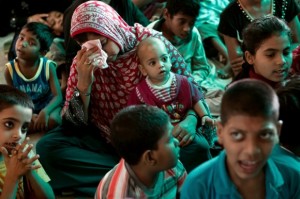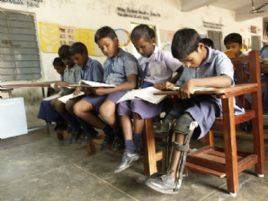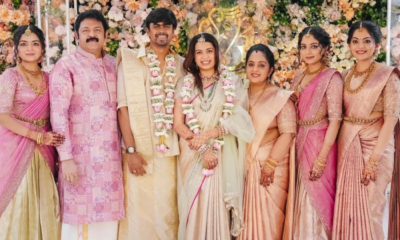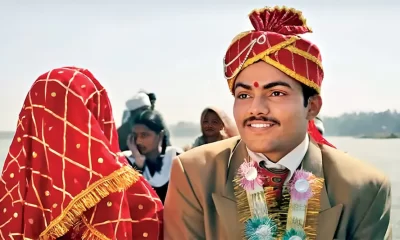In Focus
For a Dollop of Life
FWD Life traces prominent special schools in Kerala and their activities in bringing up differently-abled children to the mainstream
 A child’s birth kindles thousands of dreams in parents’ mind. They tend to dream about his growth and bright future. Irrespective of one’s social and economic status, all parents want their children to lead a comfortable life. But when they realize at one stage of the child’s growth that he/she is not like other children, needless to say, they become shattered. The perturbing fact is that in Kerala there is a considerable increase in children afflicted with disorders like mental retardation, autism, cerebral palsy, childhood mental illness, multiple disabilities and learning disorders. The report submitted by M.K. Jayaraj Commission, a one-member commission appointed by the State Government to study about the problems faced by mentally challenged children, reveals that it is high time we accepted this truth.
A child’s birth kindles thousands of dreams in parents’ mind. They tend to dream about his growth and bright future. Irrespective of one’s social and economic status, all parents want their children to lead a comfortable life. But when they realize at one stage of the child’s growth that he/she is not like other children, needless to say, they become shattered. The perturbing fact is that in Kerala there is a considerable increase in children afflicted with disorders like mental retardation, autism, cerebral palsy, childhood mental illness, multiple disabilities and learning disorders. The report submitted by M.K. Jayaraj Commission, a one-member commission appointed by the State Government to study about the problems faced by mentally challenged children, reveals that it is high time we accepted this truth.
 Bringing up such children wouldn’t be a doddle for parents. In such a situation, they rely on special schools for differently-abled children. There are over 300 special schools in Kerala. Of them, 275 are government recognized. M.K. Jayaraj, who is also the principal of State Institute for Mentally Challenged (SIMC), Pangappara, Thiruvananthapuram, told FWD Life that the inmates at SIMC included 30 orphans and people from other States as well. “There are 135 children in the school and we have 56 staff. Everything is free of cost here. Most children belong to poor families,” he said. The government recognized institutions get a grant of Rs 10 crore annually. As many as 55 special schools get grant from the Centre.
Bringing up such children wouldn’t be a doddle for parents. In such a situation, they rely on special schools for differently-abled children. There are over 300 special schools in Kerala. Of them, 275 are government recognized. M.K. Jayaraj, who is also the principal of State Institute for Mentally Challenged (SIMC), Pangappara, Thiruvananthapuram, told FWD Life that the inmates at SIMC included 30 orphans and people from other States as well. “There are 135 children in the school and we have 56 staff. Everything is free of cost here. Most children belong to poor families,” he said. The government recognized institutions get a grant of Rs 10 crore annually. As many as 55 special schools get grant from the Centre.
“If detected before three years old, their disability could be reduced to 85%.” So early intervention is vital,” he said.
Rehabilitation
 Special schools provide training to mentally challenged people as per their skills. Once they complete training, placements also will be offered. “We don’t have provision to give accommodation to inmates once they reach 18-year-old. After mastering a profession they will be sent along with their parents. But for orphans, leading a normal life will be an uphill task. I have suggested in my report about setting up a Rehabilitation Village for mentally challenged people in all districts,” added M.K. Jayaraj.
Special schools provide training to mentally challenged people as per their skills. Once they complete training, placements also will be offered. “We don’t have provision to give accommodation to inmates once they reach 18-year-old. After mastering a profession they will be sent along with their parents. But for orphans, leading a normal life will be an uphill task. I have suggested in my report about setting up a Rehabilitation Village for mentally challenged people in all districts,” added M.K. Jayaraj.
Meanwhile, he narrated a heart-breaking incident to us. A mother from Idukki cried in front of Jayaraj and asked if SIMC could adopt her three daughters afflicted with autism. “The girls are above 18-year-old. The mother was anxious about the safety of her daughters. I had limitations as we are not taking up adolescent people. So the Rehabilitation Village would be a solace for such people,” Jayaraj pointed out.
Ray of light
 As you enter the Science and Technology Museum, Thiruvananthapuram, the beautiful and sprawling garden is a visual treat for the eyes. And the hard work behind this achievement is by ten differently-abled students of SIMC who were posted as gardeners at the institute. Among them, 24-year-old Sajeev won the Best Employee Award from the President in 2011.
As you enter the Science and Technology Museum, Thiruvananthapuram, the beautiful and sprawling garden is a visual treat for the eyes. And the hard work behind this achievement is by ten differently-abled students of SIMC who were posted as gardeners at the institute. Among them, 24-year-old Sajeev won the Best Employee Award from the President in 2011.
According to Jayaraj, companies are not averse to hire differently-abled people. As many as 15 people are also appointed at Kinfra Park, Thiruvananthapuram from SIMC, which is the sole government institution for special children in Kerala.
Autism
It has been four years since actor Bindu Murali started Amma Centre for Autism, Studio Road in Thiruvananthapuram. Her eldest son is afflicted with autism and as a mother her own experience led her to start a school for children affected with autism. “There are 23 inmates and 16 of them stay in the school. Their age group is between 6-year-old and 39-year-old. The school is run in a rented house. Now that the owner has asked us to vacate the house, I am planning to buy a plot to set up the school,” said Bindu Murali.
There is dearth of trained teachers in schools for mentally challenged children. “You can’t expect people to work for measly wages. It’s very difficult to manage such children if you don’t have the patience,” she said. The school has students from Thiruvananthapuram, Wayanad, Kozhikode, Changanassery and Varkala. She has got financial contributions from film organization AMMA and Mohanlal Fans Association for the school.
Training programme
 Started in 1964, Rotary Institute for Children in need of Special Care, Thiruvananthapuram has 174 children in the age group between 5-year-old and 18-year-old. “We give them need-based training programme. After individual assessment we plan 3-month skill development programme for each of them. Of the total 42 staff, 18 of them are teachers and specialized teachers who have qualifications prescribed by the Rehabilitation Council of India,” said principal Mothy Habeeb.
Started in 1964, Rotary Institute for Children in need of Special Care, Thiruvananthapuram has 174 children in the age group between 5-year-old and 18-year-old. “We give them need-based training programme. After individual assessment we plan 3-month skill development programme for each of them. Of the total 42 staff, 18 of them are teachers and specialized teachers who have qualifications prescribed by the Rehabilitation Council of India,” said principal Mothy Habeeb.
“It is a Centre-aided institution. We give placements for the skilled children. People are not aware that such individuals can perform different jobs. Our students work at Terumo Penpol, NIMS Hospital, Vijay Petrol pump and Sreemoolam Club in Thiruvananthapuram. When we approach firms for placements, some show positive attitude and some share their apprehension citing risks. They have to create awareness among their employees about differently-abled people,” she added.
 Among the mentally challenged children 80 per cent comes under mild-moderate category. Though they will have difficulty in carrying out technical jobs, they can do jobs that are not dangerous. Baby. P.S, Manager-PR, Terumo Penpol said, “We have hired two people. One of them works as an office boy and another person works in the packing section. We treat them as normal workers. In fact, it was the management decision to hire such people. Their initial salary was Rs 1,000. Now they get a salary of Rs 7,000.” “They work as normal persons but they need our instructions to carry out things. Once they involved in an activity, they would do it without interruption,” she added.
Among the mentally challenged children 80 per cent comes under mild-moderate category. Though they will have difficulty in carrying out technical jobs, they can do jobs that are not dangerous. Baby. P.S, Manager-PR, Terumo Penpol said, “We have hired two people. One of them works as an office boy and another person works in the packing section. We treat them as normal workers. In fact, it was the management decision to hire such people. Their initial salary was Rs 1,000. Now they get a salary of Rs 7,000.” “They work as normal persons but they need our instructions to carry out things. Once they involved in an activity, they would do it without interruption,” she added.
According to a study by the UN, one among 88 children has autism and other related disorders. The prognosis is that it will be one in 20 children in future. To create awareness in the society, the problems of mentally challenged people should be included in the school syllabus. Above all, it is the attitude of the society that has to be changed.
A few special schools in Kerala
Alappuzha
- Abhaya Jyothis Special School, North Aryad.P.O, Thambakachuvadu, Alappuzha, Pin- 688 542
- K.V.M Special School, K.V.M. Trust, P.B. No-30, Cherthala, Alappuzha, Pin-688 524, Phone-0478 2812228 / 2813047
- M.E.S Institute for Mentally Handicapped (MIMH), Elippakulam P.O, Alappuzha, Pin- 690 503
Ernakulam
- Adarsh Special School, 17/298, Anjeri Madom, Elamana Road, Tripunithura, Ernakulam, Pin 682 301, Phone- 0484 278 4842
- Raksha Day Care Centre, Yasmin Manzil VII/370, Darragh-es-Salaam Road, Kochangadi, Kochi, Pin 682 002, Phone-0484 222 7707
- Nirmalagiri Vocational Rehabilitation Centre, Mudavoor P.O, Muvattupuzha, Pin- 686 669, Phone- 0485 281 2170.
Idukki
- Asha Bhavan Special School, Nedumkandam P.O, Kattappana, Pin- 685 553
- Carmel Jyothi Centre for Mentally Retarded Children, Machiplavu P.O, Adimaly, Pin- 685 561
- Pratheeksha Bhavan, Thodupuzha P.O, Pin- 685 584, Phone- 04862 229 144
Kannur
- Jaycee Special School, Sathram Road, Dharmadam P.O, Thalassery, Pin- 670 106, Phone- 0490 234 6813
- St. Theresa’s Home, Pattuvam P.O, Thaliparambu (via), Kannur, Pin-670 143, Phone- 04982 220 677
- Vikas Bhavan Special School, Edoor, Payam P.O, Pin- 670 704, Phone- 0490 245 0322
Kasargode
- Karuna Special School, Alampady P.O, Kasargode, Pin- 671 123, Phone- 04997 420 584
- Rotary Special School, Rotary Village, Anandasram P.O, Kanhangad, Pin- 671 531
- St. Joseph Special School, Chullikkara, Padimaruthu P.O, Pin 671 531, Phone 0467 222 6886
Kollam
- Karuna Special School, Chavara South P.O, Vadakkumbhagam, Pin 691 584, Phone- 0476 288 2354
- Seiri Asha Bhavan, Valacode P.O, Punalur, Pin- 691 331, Phone- 0475 222 3260
- Vikas Bhavan, Y.W.C.A, Pin 691 001, Phone- 0474 274 6157
Kottayam
- Asha Bhavan, Veroor P.O, Changanacherry, Pin 686 104, Phone- 0481 272 1196
- St. John of God Special School, Velloor P.O, Pin 686 501, Phone 0481 237 3006
- Vikas Vidyalaya, Chelliozhukam Road, Pin 686 001, Phone- 0481 256 1744
Kozhikode
- Ashakiran School for Differently-abled Children, Medical College P.O, Devagiri, Pin- 673 008, Phone- 0495 2355 641
- Pratheeksha Special School, Mukkom P.O, Mampetta, Pin- 673 602
- Sneha Mahal, Centre for Mentally Handicapped, Sneha Nagar, Kolathara P.O, Pin 673 655, Phone- 0495 2402258
Malappuram
- Good Hope School, Achipilakkal, Karuvambram P.O, Manjeri, Pin 676 123, Phone- 0483 2768 401
- Karunya Bhavan, Vazhakkad P.O, Edavannappara, Pin- 673 640, Phone- 0483 276 8401
- P.K.M. School, Jubily Road, Perinthalmanna, Pin- 679 322,
Palakkad
- Ashadeepam Convent School, Koonathara P.O, Shornur (via), Pin- 679 523
- Faith India (FIMM School), Viyyakkurussi P.O
- St. Dominic’s Special School, Perimbadari P.O, Mannarkkad, Pin- 678 762
Pathanamthitta
- Bethany Santhy Bhavan, Kadamankulam P.O, Kallooppara, Thiruvalla, Pin- 677 902
- Sanjose Pratheeksha Bhavan, Pudhussery South P.O, Thiruvalla, Pin- 689 602
- Vikas School, YMCA, Thiruvalla, Pin- 689 101, Phone- 0469 260 2521
Thrissur
- Madonna Special School, Potta, Chalakkudy, Pin- 680 722, Phone- 0488 270 2697
- Pope Paul Mercy Home, Peringadoor P.O, Pin- 680 581, Phone- 0487 2200 261, e-mail: [email protected]
- Pratheeksha Training Centre, Christ Nagar, Irinjalakuda, Pin- 680 125, Phone: 0480 282 5020
Trivandrum
- Developmental Centre for Mentally Retarded (DCMR), DPI Junction, Jagathy, Pin-695 014, Phone- 0471 232 5508
- PRS Pillay Memorial Balavikas Institute, Opp. Hindustan Latex, Gandhi Marg, Peroorkkada, Pin 695 005
- SIMH, Govt. Home for Mentally Retarded, Pangappara, Sreekaryam, Phone- 0471 241 8524
Wayanad
- Emmaus Villa, Thonichal, Nallurnad P.O, Mananthavady, Pin- 670 645
- Fr. Tezza’s Training Centre, Kuttiyamvayal, Varampatta P.O, Pin- 673 575
- Nirmal Jyothi School, Thoduvetty, Puthenkunnu P.O, Sulthan Bathery, Pin-673 592
Cover Story
Unraveling the Mystique: Leap Day Myths from Around the Globe

Leap day, that enigmatic extra day added to our calendars every four years, has long been shrouded in mystery and folklore. Across cultures and continents, various myths and beliefs have emerged surrounding this rare occurrence. Let’s embark on a journey to explore some of the fascinating leap day myths from around the world.
The Irish Tradition of Women Proposing:

One of the most well-known leap day traditions originates from Ireland. According to Irish folklore, St. Bridget struck a deal with St. Patrick, allowing women to propose to men every leap day. It was believed that this reversal of traditional gender roles would bring good luck and fortune to the couple. While this custom may seem antiquated in modern times, it serves as a reminder of the evolving nature of societal norms and the persistence of age-old customs.
Greek Superstitions:

In Greece, leap years are often associated with superstitions and caution. It is believed that any actions taken during a leap year, especially major decisions like marriage or starting a business, may be fraught with misfortune. Consequently, many Greeks prefer to postpone significant endeavors until the following year, avoiding the perceived risks associated with leap years. This superstition highlights the deeply ingrained cultural beliefs surrounding auspicious timing and the fear of tempting fate.
Leap Day Babies:

For individuals born on February 29th, known as leap day babies or leaplings, their birthdays hold a special significance that transcends conventional calendar dates. In various cultures, leap day babies are said to possess unique qualities or destinies. Some believe they are endowed with good luck, while others consider them to be blessed with eternal youth. Regardless of the superstitions, leap day babies serve as a reminder of the extraordinary nature of time and the quirks of our calendar system.
The Perplexing Aztec Calendar:

Among the ancient civilizations of Mesoamerica, such as the Aztecs, leap years held particular significance within their complex calendrical systems. The Aztec calendar, known as the Xiuhpohualli, consisted of 365 days divided into 18 months, with an additional five “nameless” days at the end of the year. To reconcile the solar year with their calendar, the Aztecs periodically inserted leap days, known as Nemontemi, to ensure alignment with the agricultural and celestial cycles. These leap days were associated with rituals and ceremonies, underscoring the interconnectedness of time, culture, and cosmology.
Lunar Leap Day in China:

In traditional Chinese culture, leap years are intricately linked to the lunar calendar and the celebration of the Chinese New Year. Known as a “leap lunar month,” this phenomenon occurs approximately every three years within the Chinese calendar cycle. During a leap lunar month, an extra lunar month is added to maintain synchronization with the solar year. This adjustment ensures that traditional festivities, such as the Lunar New Year, occur at the appropriate seasonal intervals, preserving centuries-old customs and cultural heritage.
Leap day serves as a captivating intersection of timekeeping, tradition, and folklore, weaving a tapestry of myths and beliefs from diverse cultures around the world. Whether it’s the Irish tradition of women proposing, Greek superstitions, the enigmatic Aztec calendar, or the intricacies of the Chinese lunar cycle, leap day continues to captivate our imagination and inspire wonder. As we embrace the fleeting nature of this extra day, let us reflect on the rich tapestry of human ingenuity and the enduring legacy of our collective beliefs and customs.
Beauty
Jennifer Lopez’s Daring Fashion Choice: A Wetsuit-Inspired Gown Steals the Spotlight on the Red Carpet

When it comes to making a statement on the red carpet, Jennifer Lopez is no stranger to turning heads. The multi-talented star recently attended the premiere of “The Flash” to support her husband, Ben Affleck, who reprises his role as Batman. While their public display of affection grabbed attention, it was their coordinated and eye-catching outfits that truly stole the show. Lending her style expertise, J Lo stepped out in a bold and unconventional gown inspired by wetsuit designs, proving that she continues to push the boundaries of fashion.

Styled by the talented duo Rob Zangardi and Mariel Haen, her gown was a striking creation from Gucci’s resort 2023 collection, fresh off the runways of Seoul. The ensemble featured a sleek black zip-up bodice reminiscent of scuba suits, adding a unique and unexpected element to the traditional red carpet attire. Contrasting the sporty top, a flowing peach satin maxi skirt with a long train exuded elegance and femininity.
While the gown was originally presented on the runway with a fully zipped-up collar, J Lo made a daring choice to unzip hers just above the belly button. This modification transformed the look into a more revealing and sensual ensemble, showcasing the star’s confidence and willingness to embrace risks. With every step, the gown accentuated her enviable figure, commanding attention and setting a new standard for red carpet fashion.

To complete her show-stopping look, Jennifer Lopez made careful choices when it came to accessories. She opted for a pair of white leather platform pumps from Gucci, elevating her height and adding a touch of sophistication. The choice of accessories further emphasized the fusion of sporty and elegant elements in her outfit. Complementing the gown’s black bodice, she adorned herself with exquisite jewelry pieces from Daniela Villegas and Le Vian, adding a touch of luxury and sparkle. Carrying a sleek black leather clutch bag by Kurt Geiger, J Lo effortlessly showcased her ability to curate every aspect of her ensemble.
One cannot overlook the sartorial synchrony between Jennifer Lopez and her husband, Ben Affleck. Affleck, known for his impeccable red carpet style, consistently mirrors the overall vibe of J Lo’s look. For the premiere, he opted for an all-black ensemble, comprising a sleek black suit, a matching black shirt, and polished black leather dress shoes. The couple’s synchronized fashion choices not only showcase their undeniable chemistry but also demonstrate their commitment to presenting a cohesive and visually appealing appearance together.
Jennifer Lopez continues to push fashion boundaries and surprise the world with her red carpet choices. Her wetsuit-inspired gown at “The Flash” premiere exemplifies her fearless approach to style. By incorporating sporty elements into a sophisticated ensemble, she proves that fashion can be both daring and elegant. Alongside her partner Ben Affleck, the power couple’s synchronized looks create an awe-inspiring visual spectacle, solidifying their status as fashion icons. J Lo’s ability to effortlessly command attention and make fashion statements ensures that she remains an influential force in the world of celebrity style.
Fashion
Unveiling the Mystery : The Rise of ‘Quiet Luxury’ – The Viral and Ultra-Expensive Fashion Trend Followed by Billionaires

In the world of fashion, where flamboyance and opulence often take center stage, a new trend has quietly emerged, captivating the attention of celebrities, billionaires, and fashion enthusiasts alike. Known as “Quiet Luxury,” this viral and ultra-expensive fashion trend is causing waves in the industry, challenging the conventional notions of wealth display and style.
While many high-end luxury brands are known for their ostentatious and eye-catching designs, ‘Quiet Luxury’ takes a different approach. It revolves around the concept of dressing in understated, label-less clothing that exudes an aura of sophistication and exclusivity, despite its seemingly ordinary appearance. This trend has gained significant traction over the past few months, with influential figures embracing its allure.
So, what exactly is ‘Quiet Luxury’? At its core, it is a form of subtle wealth display, where the wealthiest individuals meticulously curate their attire with understated tones, simple cuts, and an absence of prominent logos. These seemingly unassuming garments, however, come with exorbitant price tags, often costing a small fortune.

One notable incident that brought ‘Quiet Luxury’ into the spotlight was Gwyneth Paltrow’s appearance in court, clad in an impeccably tailored but discreet pantsuit. This choice perfectly exemplified the essence of ‘Quiet Luxury,’ showcasing the ability to convey elegance and affluence without resorting to overt displays of wealth.
The appeal of ‘Quiet Luxury’ lies in its ability to provide billionaires with a paradoxical blend of ordinariness and exclusivity. By adorning themselves in seemingly commonplace clothing, these individuals are able to blend in with the masses while exuding an air of refinement and extravagance. The garments they choose may appear unassuming to the untrained eye, but their true worth is hidden in the finest craftsmanship, luxurious materials, and meticulous attention to detail.
One prime example of this trend can be found in the wardrobe of Facebook founder Mark Zuckerberg, often seen sporting plain white or grey t-shirts that carry a hefty price tag. Such minimalistic pieces become the epitome of ‘Quiet Luxury,’ encapsulating the allure of hidden opulence within simplicity.
While ‘Quiet Luxury’ is not an entirely novel concept, its popularity has surged in recent times. The trend offers a safe and non-risky approach to fashion, favoring monochrome palettes, classic cuts, and timeless styles that are unlikely to fade away. This makes ‘Quiet Luxury’ an attractive option for those who seek to present themselves as both presentable and affluent, while also ensuring their fashion choices remain perpetually relevant.

In an era where ostentatious displays of wealth often dominate the fashion landscape, ‘Quiet Luxury’ stands as a captivating alternative, enticing the ultra-rich with its subtle allure. By embracing this trend, billionaires and celebrities alike have found a way to project their affluence with grace and sophistication, making a powerful statement without uttering a word.
As the influence of ‘Quiet Luxury’ continues to grow, we can only speculate on how this trend will shape the fashion industry in the coming years. Perhaps it will inspire a broader shift towards understated elegance and timeless style, encouraging individuals to redefine what it truly means to be fashionably wealthy.
-

 Style11 months ago
Style11 months agoBridal Guide : Best Looks of Radhika Merchant Ambani
-

 Entertainment1 year ago
Entertainment1 year agoBridal Bliss : All Bridal Looks of Swasika Vijay
-

 Movies1 year ago
Movies1 year agoA Nostalgic Journey Through Love &Cinema : Best Bollywood Romantic 90s Movies
-

 AD9 months ago
AD9 months agoPopular Curtain Fabrics to Consider for Your Home
-

 Events9 months ago
Events9 months agoBest of Fashion Looks : Diya Krishna Wedding
-

 Events9 months ago
Events9 months agoThe L’Oréal Paris Show at Paris Fashion Week 2024
-

 news9 months ago
news9 months agoLaapataa Ladies: Kiran Rao’s Social Satire Becomes India’s Official Entry for the 2025 Oscars
-

 People1 year ago
People1 year ago10 Star-Studded Ventures Owned by Malayalam Celebrities

























